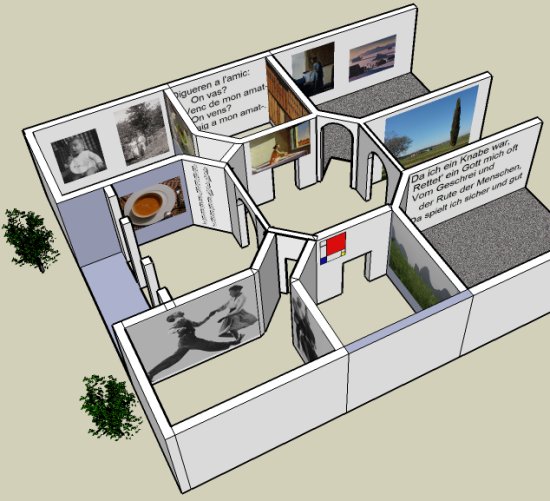Everybody has had the necessity of memorizing a particular text or a collection of items and wished to improve his ability of retention.
It seems that the greek lyric Simonides of Ceos 556 BCE- 468 BCE), while attending a dinner hosted by his patron Scopas, left the room just before the ceiling collapsed. Everyone was killed and the corpses were so badly damaged that could not be recognized. However, Simonides was able to identify them just by the position they had in the table. Out of this experience Simonides drew out the “method of loci” for remembering texts: associate each fragment with an image located in a particular place in a particular room. It is referred by Quintilian ((Calahorra, 35-100) inInstitutio Oratoria (chap.2 p.219 English translation) or Cicero in De Oratore(Book II, p.216).
The art of memory was an important part in the study of rethoric. The roman tradition persisted in the middle ages. If there is a complex set of items to remember, instead of a single room, several chambers of a building are a better option. The jesuit Matteo Ricci (1552 161), missionary in China, refers to “Palaces of memory” in his treatrise on Mnemonics. Although it’s not really required, he suggests to choose an actual building, a palace, or a temple, and place in its chambers different images related to the texts that have to be retained. When in need to retrieve some content, we only have to walk mentally trough the chambers of the palace, visualizing the images we placed before and, out of them, the contents associated with. The device works, we all are able, when far from home, to close our eyes, open mentally the door of the appartment, and walk all our chambers while “looking” at the furniture and objectes we have there.
Other personages tried similar techniques. Giordano Bruno who, by the way, in some points took inspiration from Ramon Llull’s Ars Combinatoria, based his system on the twelve houses of the Zodiac (those with more knowledge of latin than me can profit from this link: Ars memoriae within De Umbris Idearum. In modern times, champions of memory like Dominic O’brien, who can remember in the right order about 2800 cards after seeing them only once, uses similar procedures.
Without pretendint to emulate those feats, anybody can buid his own palace of memory and use it to remember subjects of a test, or a speech. Here you can find clear instructions: http://www.wikihow.com/Build-a-Memory-Palace
1) Draw the blueprint of your palace and define a route, it can be your room, or your appartment
2) Place the things to be remembered
3) Explore and practise
It’s likely that the expression “in the first place … in the second place” can be related to this technique. Or, in spanish, “tener la cabeza bien amueblada” (to have a well furnished mind).
Besides being a useful device, I find the idea of palaces of memory extremely suggestive. We can be poor in terms of real state but we can always build a palace of memory, furnish and decore it with our treasures. There could be windows to a backyard where we chased beetles when we were eleven, on a wall in the corridor with some verses we love, in the next chamber the smell of the sea, in another the taste of a cake our mother cooked for us -our particular proustian madeleine-, in a cupboard a route through little streets in a city we visited last holidays, rooms where we hang pictures from different museums creating our own art gallery, salons where a Schubert trio can be listened to and, downstairs in the basement, the sound of Ray Brown’s bass from a club session six years ago.
Anytime we can close the eyes and, as such wealthy owners that we are, walk the main corridor opening the doors of the different chambers finding lots of things we carefully stored there.

